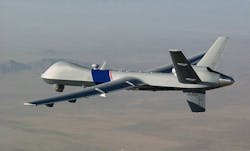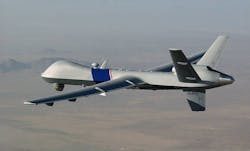GA-ASI Predator B detects and tracks ballistic missile during airborne missile defense test
SAN DIEGO, 16 August 2016. Engineers at General Atomics Aeronautical Systems Inc. (GA ASI) – a manufacturer of remotely piloted aircraft (RPA) systems, radars, electro-optic, and related mission systems solutions in Poway, California – executed a missile tracking test under a Missile Defense Agency (MDA) contract.
Two Predator B RPA (also known as an unmanned aircraft system or UAS) equipped with Raytheon Multi-spectral Targeting Systems-B (MTS-B) electro-optical/infrared (EO/IR) turrets were used to detect and track a ballistic missile (BM) target as part of an ongoing program with MDA. The Predator B aircraft also participated in exercises with U.S. Navy vessels.
“The test provided valuable data in our ongoing effort to develop an effective airborne missile defense capability,” says, GA-ASI CEO Linden Blue.
The multi-mission Predator B/MQ-9 Reaper, a technologically advanced derivative of the combat-proven Predator, is a long-endurance, medium- to high-altitude RPA designed to be used for surveillance, military reconnaissance, and targeting missions. The current aircraft configuration, featuring an extensive payload capacity and powered by a Honeywell turboprop engine with an altitude of over 45,000 feet, is currently operational with the U.S. Air Force, U.S. Department of Homeland Security, NASA, and a number of NATO countries.
The airborne missile defense test was performed as part of the Pacific Dragon (PD) exercise held off the coast of the Pacific Missile Range Facility (PMRF) in Kauai, Hawaii. Pacific Dragon – a trilateral Ballistic Missile Defense (BMD) tracking event between the U.S. Navy, Japan Maritime Self Defense Force, and Republic of Korea Navy – is a biennial exercise focuses on improving tactical and technical coordination among its participants, including the detection, tracking, and reporting of ballistic targets.
General Atomics Aeronautical Systems Inc., an affiliate of General Atomics, delivers situational awareness by providing remotely piloted aircraft systems, radars, and electro-optic and related mission systems solutions for military and commercial applications worldwide. The company’s Aircraft Systems business unit is a designer and manufacturer of proven, reliable, RPA systems, including Predator A, Predator B/MQ-9 Reaper, Gray Eagle, the new Predator C Avenger, and Predator XP. It also manufactures a variety of state-of-the-art digital Ground Control Stations (GCS), including the next-generation Advanced Cockpit GCS, and provides pilot training and support services for RPA field operations.
The Mission Systems business unit designs, manufactures, and integrates the Lynx Multi-mode Radar and sophisticated Claw sensor control and image analysis software into both manned and remotely piloted aircraft. It also focuses on providing integrated sensor payloads and software for intelligence, surveillance, and reconnaissance (ISR) aircraft platforms and develops high energy lasers, electro-optic sensors, and meta-material antennas.
Search the Aerospace & Defense Buyer's Guide
You might also like:
Subscribe today to receive all the latest aerospace technology and engineering news, delivered directly to your e-mail inbox twice a week (Tuesdays and Thursdays). Sign upfor your free subscription to the Intelligent Inbox e-newsletter at http://www.intelligent-aerospace.com/subscribe.html.
Connect with Intelligent Aerospace on social media: Twitter (@IntelligentAero), LinkedIn,Google+, and Instagram.
Intelligent Aerospace
Global Aerospace Technology NetworkIntelligent Aerospace, the global aerospace technology network, reports on the latest tools, technologies, and trends of vital importance to aerospace professionals involved in air traffic control, airport operations, satellites and space, and commercial and military avionics on fixed-wing, rotor-wing, and unmanned aircraft throughout the world.


